外研社高一英语必修一unit1说课稿
- 格式:pptx
- 大小:5.26 MB
- 文档页数:23
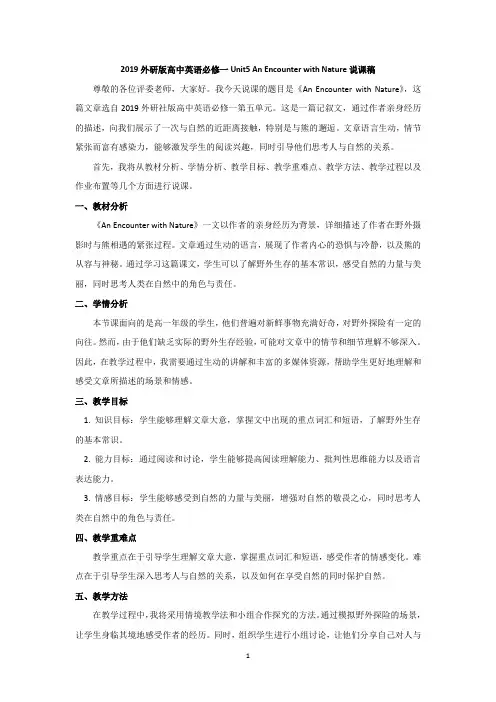
2019外研版高中英语必修一Unit5 An Encounter with Nature说课稿尊敬的各位评委老师,大家好。
我今天说课的题目是《An Encounter with Nature》,这篇文章选自2019外研社版高中英语必修一第五单元。
这是一篇记叙文,通过作者亲身经历的描述,向我们展示了一次与自然的近距离接触,特别是与熊的邂逅。
文章语言生动,情节紧张而富有感染力,能够激发学生的阅读兴趣,同时引导他们思考人与自然的关系。
首先,我将从教材分析、学情分析、教学目标、教学重难点、教学方法、教学过程以及作业布置等几个方面进行说课。
一、教材分析《An Encounter with Nature》一文以作者的亲身经历为背景,详细描述了作者在野外摄影时与熊相遇的紧张过程。
文章通过生动的语言,展现了作者内心的恐惧与冷静,以及熊的从容与神秘。
通过学习这篇课文,学生可以了解野外生存的基本常识,感受自然的力量与美丽,同时思考人类在自然中的角色与责任。
二、学情分析本节课面向的是高一年级的学生,他们普遍对新鲜事物充满好奇,对野外探险有一定的向往。
然而,由于他们缺乏实际的野外生存经验,可能对文章中的情节和细节理解不够深入。
因此,在教学过程中,我需要通过生动的讲解和丰富的多媒体资源,帮助学生更好地理解和感受文章所描述的场景和情感。
三、教学目标1. 知识目标:学生能够理解文章大意,掌握文中出现的重点词汇和短语,了解野外生存的基本常识。
2. 能力目标:通过阅读和讨论,学生能够提高阅读理解能力、批判性思维能力以及语言表达能力。
3. 情感目标:学生能够感受到自然的力量与美丽,增强对自然的敬畏之心,同时思考人类在自然中的角色与责任。
四、教学重难点教学重点在于引导学生理解文章大意,掌握重点词汇和短语,感受作者的情感变化。
难点在于引导学生深入思考人与自然的关系,以及如何在享受自然的同时保护自然。
五、教学方法在教学过程中,我将采用情境教学法和小组合作探究的方法。
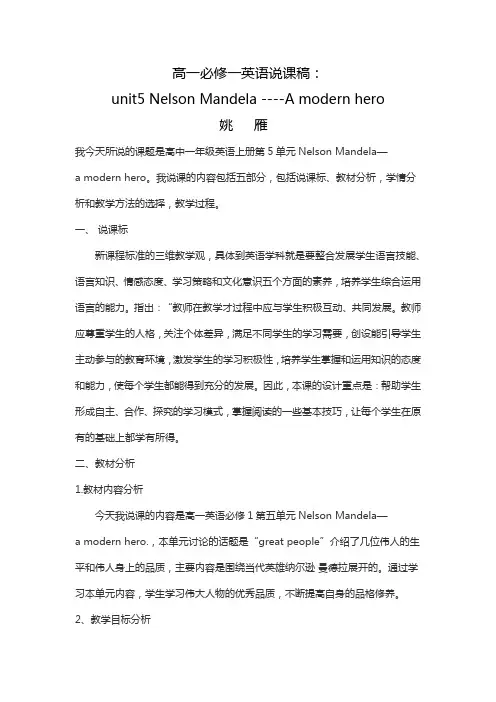
高一必修一英语说课稿:unit5 Nelson Mandela ----A modern hero姚雁我今天所说的课题是高中一年级英语上册第5单元Nelson Mandela—a modern hero。
我说课的内容包括五部分,包括说课标、教材分析,学情分析和教学方法的选择,教学过程。
一、说课标新课程标准的三维教学观,具体到英语学科就是要整合发展学生语言技能、语言知识、情感态度、学习策略和文化意识五个方面的素养,培养学生综合运用语言的能力。
指出:“教师在教学才过程中应与学生积极互动、共同发展。
教师应尊重学生的人格,关注个体差异,满足不同学生的学习需要,创设能引导学生主动参与的教育环境,激发学生的学习积极性,培养学生掌握和运用知识的态度和能力,使每个学生都能得到充分的发展。
因此,本课的设计重点是:帮助学生形成自主、合作、探究的学习模式,掌握阅读的一些基本技巧,让每个学生在原有的基础上都学有所得。
二、教材分析1.教材内容分析今天我说课的内容是高一英语必修1第五单元Nelson Mandela—a modern hero.,本单元讨论的话题是“great people”介绍了几位伟人的生平和伟人身上的品质,主要内容是围绕当代英雄纳尔逊曼德拉展开的。
通过学习本单元内容,学生学习伟大人物的优秀品质,不断提高自身的品格修养。
2、教学目标分析新课标提出了立体三维教学目标,本课我设计的教学目标如下:1)知识目标:熟悉本课的一些新单词,短语和句型。
语法方面掌握语法方面掌握以where,when, why,介词+which,介词+whom引导的定语从句2)能力目标:训练学生的阅读技巧(略读、寻读等),形成用英语获取信息、处理分析信息的能力。
并鼓励学生开口说英语。
3)情感态度目标:①通过学习激发学生对英语学习的浓厚兴趣;②使学生在领会语言丰富多彩性的同时学习伟大人物的优秀品质,不断提高自身的品格修养。
③通过对课文学习的小组讨论等形式,帮助学生养成团结、协作的品质。
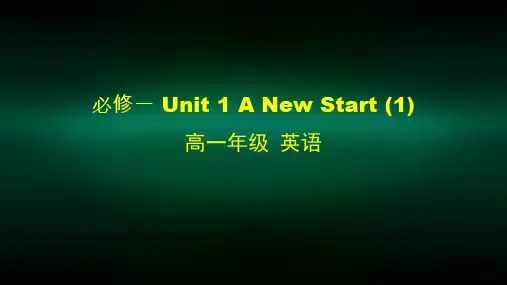
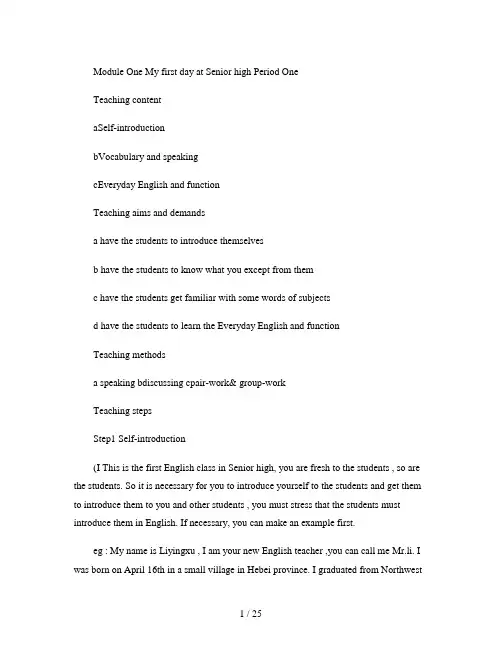
Module One My first day at Senior high Period OneTeaching contentaSelf-introductionbVocabulary and speakingcEveryday English and functionTeaching aims and demandsa have the students to introduce themselvesb have the students to know what you except from themc have the students get familiar with some words of subjectsd have the students to learn the Everyday English and functionTeaching methodsa speaking bdiscussing cpair-work& group-workTeaching stepsStep1 Self-introduction(I This is the first English class in Senior high, you are fresh to the students , so are the students. So it is necessary for you to introduce yourself to the students and get them to introduce them to you and other students , you must stress that the students must introduce them in English. If necessary, you can make an example first.eg : My name is Liyingxu , I am your new English teacher ,you can call me Mr.li. I was born on April 16th in a small village in Hebei province. I graduated from NorthwestMinorities University , I have taught English in this school for three years. I am a friendly teacher , I am usually ready to help everyone of you. I like sports very much ,but I am not good at it. I don’t like music so much ,especially pop music, in my opinion, it is so noisy and meaningless. In my spare time, I like reading. I hope we can get along well with each other and I will try my best to teach you how to learn English well more than the grammar & vocabulary & drills. I will be strict with every student, so you must follow my words, or you will be punished.(some drills needed to be written on the black boarda My name is ……b I am a ……c I was born on/in ……d I graduated from ……e I like/ am good at / am fond of ……f I hope/ think/ want ……g ……(II Get the students to introduce them to their partners in group of four, then ask some volunteers to introduce them to all the students in English. orAsk them to introduce them one by one.Step2 Vocabulary and speaking(I VocabularyAsk the students to tell you what subjects they learned in Junior High school and what other subjects they will learn in Senior High school, ask the students to express them in English as possible as they can, then write the words on the Bb, teach the students to pronounce the words they don’t know.eg : Chinese English Mathematics Physics Chemistry Biology Politics History Geography Arts Music IT (Information Technology PE(Physical Education GT(General Technology Japanese Russian French(IIDialogue (pair-workT: How many subjects are science subjects?S: ……T: How many of them are languages?S: ……T: Which languages do you study at our school?S: .…..T: Which subjects do you like best? Why?S: ……Ask the students to imitate the dialogue to get which subject their partner like and why by using the following drills.Which subject do you like best? Why?Which subject do you like better between ...and …? Why?I like … because …I think … is important because …I would like to study/learn … because …In my opinion … is … so I …..Ask some of them to show their dialogues to the ss.Step 3 Everyday English and Function(I T: After we have talked about the favorite subjects you like best, now lets turn to another part. Every day when we have a break between classes we may meet some old friends, you may talk abo ut your classes , now please turn to P8 , let’s learn the dialogue in Everyday English and Function .Ask the students to listen to the tape ,then to read the dialogue in pairs. (explain some difficult words and teach ask them to pronounce them by looking up them in the dictionary Ask the students to read and analyze these sentences.1 How are you doing?2 Oh really?3 Is that right?(II Work in pairs. Make a conversation about one of your classes . Use the conversation in activity 1 to help. Ask some of them to report and act their dialogue out.Step4 SummaryThe teacher summary the whole class for the students and tell them what they should do to improve .HomeworkI Review the drills we learned in this class.II Preview Reading and vocabulary & Cultural corner.Period 2Teaching contenta Reading and vocabularyb Cultural cornerTeaching aims and demandsa get the students to understand the texts wellb get the students to know the school life in other schools ( at home and in the USAc help the students to improve their reading abilityTeaching methodsa speakingb readingc discussingd pair-work& group-workTeaching stepsStep 1 RevisionI Revise last class by ask them which subject they like best and why.II Revise everyday English by asking which class do you have before our English class and talk about it with the help of Everyday English and Function on P8Step 2 Lead-in (Discuss and compareT: Everybody , we have studied in a new school named Pingluo Middle School . Before you come here , all of you studied in different schools, now I will give you some time to think what the main differences and similarities between Junior High school and Senior High school.And ask them to discuss these two problems:1 Do you think that work at Senior High school is harder than that at Junior High school?2 Are Senior High teachers similar to Junior High teachers?T: After we have compared Senior High school and Junior High school, now we will learn something about Likang’s First day at Senior High . before we read the text let’s learn some words first.Step 3 VocabularyDeal with the vocabulary on P2 by finishing the questions in the part.Step 4 ReadingI ScanningRead the text quickly and try to find the answer to these questions:a What are the differences between Likang’s Junior High school and Senior High school?b What are the two things the English teacher thinks important to do in class?c What are the two things that the English teacher want to improve?II UnderstandingPlay the tape for the students and ask them to listen & read following the tape in a low voice. Then finish the forth part in Reading and Vocabulary on P3.III Careful-readingAsk the students to read the passage again and find out which word in the box in the fifth part of Reading and Vocabulary on P4. And ask them try to guess the meaning and explain the words in English according to the text.Ask the students to read the three summaries of Likang’s opinion about the new school in the sixth part in Reading and Vocabulary on P4. Decide which is the best.IV DiscussionT: We have known the Likang’s life at Senior High, is your English classroom like Likang’s? is your class the same size as his? Is the number of boys and girls the same? Are you looking forward to doing your English homework? Now please discuss with your partner and compare your school life with Likang’s.Step5 Cultural cornerT: we have learned likang’s school life at senior high, do you want to know the life of the teenagers in the similar age of you in other countries? Now please turn to P9, let’s read the text in cultural corner and learn something about the Senior High school life in the US.I Ask the students to listen to the tape and read the text.II Ask the students to answer the following questions:a What are the differences between the grades in China and the US?b How is the school year divided ?c How long does the Summer Vacation last?d When do they start and finish school?e What do they do after school?III Ask the students to prepare a short reply to introduce the school system , vacation, study time & after-school activities in China by imitating the letter in Cultural corner.Step6 SummaryThe teacher summary the class by comparing the school life in China and the US.Homework:I Write a reply to Rob MarshallII Read the text for as many times as they canIII Preview the language points in these two passages.Period 3Teaching contenta the language points in the two passagesb the important and difficult drills in the two passagesTeaching aims and demandsa get the students to master some useful words or expressionsb get the students to master some important drillsc get the students to do some exercises about the language points.d to improve the students ability of using EnglishTeaching methodsa Explainingb Discoveringc PracticingTeaching stepsStep 1 RevisionRevise last class by checking home work and analyze the students’ replies. You can also ask some the students to read the good replies for the studentsStep 2 Language StudyI Underline the useful expressionsscience subjectacademic subjectbe similar to… differences between A and Bthe attitude to… teaching method a city not far from … wr ite down… on the computeron the screeninformation from websites a woman called…. be nothing likespeak a lot in class have fun introduce oneselfin groups give sb instructions work by oneselfimprove one’ s spelling in a fun way in other wordsfor one’ s homework a description of look forward to doing…be impressed with… A is the same size as Bthe number ofthe American school systems secondary schoolcover 7 years receive the high school diploma go to collegedivide….into.. September through December take part inbe free to do… without the help of sbbecome friendslast a long timeThere is a popular belief They say thathave similar life experiences under the same roof Thanks for doing…ask sb about… do experimentshave dinnerstay on at school take a bus homeschool daybe fluent in Chinese speak Chinese with fluency make a lot of progressat the beginning of write to sb all over the worldthe smell of paint the wall move to…have the biggest smileII Analyze the language pointsA Words1 information noun facts or details telling sth about a situation, person ,event, etc information about/on sb/sth 关于某人 /谋事的信息a piece of information 一则消息; 一份情报ask for information on/about 打听关于…… 的消息 2 instruction n (pl sth that sb tells you to do 指示(pl information on how to do or use sth 说明follow the instructions for 遵守…… 的指示instructions on(how to do sth (如何做某事的指示instructions to do sth 做某事的指示on sb’ instructions遵照某人的指示be under instructions to do sth 被指示做某事instructions in 有关…… 的指示3 embarrassed adj. feeling nervous and uncomfortable and worryingbe embarrassed to do sth 羞于做某事be embarrassed about/at 对…… 感到困窘4 attitude n sb’s opinion s of feelings about sth, especially as shown by their behaviourattitude to/towards sth/sb 对某人 /某事的态度5 behaviour n way of treating others ; mannersbehaviour towards/to …… 对…… 的态度 /行为be on one’ s good/best behaviour 循规蹈矩;行为检点put sb on his best behaviour 规劝 /警告某人要规规矩矩6 previous adj happening or existing before the event or object you are talking about 以前的;从前的the previous day 前一天previous to 在…… 以前previously adv 以前;从前7 impress vt. to have a favourable effect on sb ; to make sb feel admiration and respect impress sth in /on sthimpress sth on/opon sbimpress sb with sthbe impressed at/by/withimpression n.make an impression on sb8 cover vt to include or deal with sth 包含be covered by/ with被…… 所覆盖cover for sb 顶替某人cover (a distance 走(一段距离cover (sth new 报道(消息;新闻cover sth up/over 盖住某物Step 3 PracticingAsk the students to do some exercises about the language points just learnedHomeworkI Remember the usages of the words todayII Preview and try to analyze the difficult sentences in these to passagesPeriod 4Teaching contenta the language points in the two passagesb the important and difficult drills in the two passagesTeaching aims and demandsa get the students to master some useful words or expressionsb get the students to master some important drillsc get the students to do some exercises about the language points.d to improve the students ability of using EnglishTeaching methodsa Explainingb Discoveringc PracticingTeaching stepsStep 1 RevisionRevise the words learned yesterday by doing some translation exercises.(C to E or E to C.Step 2 language study1. The teacher is a very enthusiastic woman called Ms. Shen.这个非常热情的女老师是沈老师。
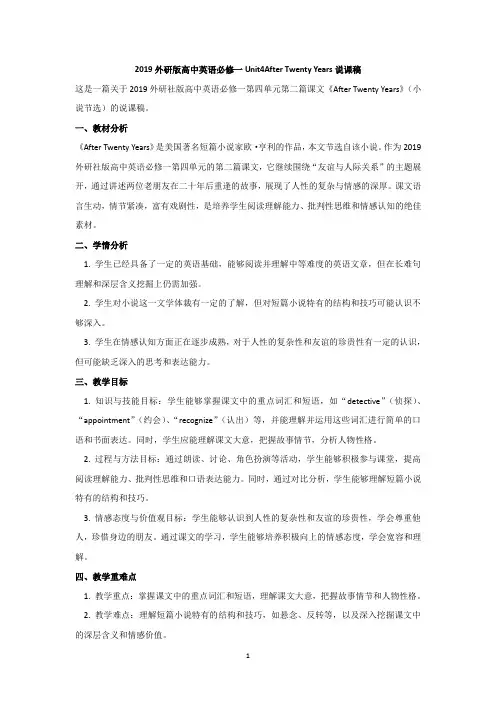
2019外研版高中英语必修一Unit4After Twenty Years说课稿这是一篇关于2019外研社版高中英语必修一第四单元第二篇课文《After Twenty Years》(小说节选)的说课稿。
一、教材分析《After Twenty Years》是美国著名短篇小说家欧·亨利的作品,本文节选自该小说。
作为2019外研社版高中英语必修一第四单元的第二篇课文,它继续围绕“友谊与人际关系”的主题展开,通过讲述两位老朋友在二十年后重逢的故事,展现了人性的复杂与情感的深厚。
课文语言生动,情节紧凑,富有戏剧性,是培养学生阅读理解能力、批判性思维和情感认知的绝佳素材。
二、学情分析1. 学生已经具备了一定的英语基础,能够阅读并理解中等难度的英语文章,但在长难句理解和深层含义挖掘上仍需加强。
2. 学生对小说这一文学体裁有一定的了解,但对短篇小说特有的结构和技巧可能认识不够深入。
3. 学生在情感认知方面正在逐步成熟,对于人性的复杂性和友谊的珍贵性有一定的认识,但可能缺乏深入的思考和表达能力。
三、教学目标1. 知识与技能目标:学生能够掌握课文中的重点词汇和短语,如“detective”(侦探)、“appointment”(约会)、“recognize”(认出)等,并能理解并运用这些词汇进行简单的口语和书面表达。
同时,学生应能理解课文大意,把握故事情节,分析人物性格。
2. 过程与方法目标:通过朗读、讨论、角色扮演等活动,学生能够积极参与课堂,提高阅读理解能力、批判性思维和口语表达能力。
同时,通过对比分析,学生能够理解短篇小说特有的结构和技巧。
3. 情感态度与价值观目标:学生能够认识到人性的复杂性和友谊的珍贵性,学会尊重他人,珍惜身边的朋友。
通过课文的学习,学生能够培养积极向上的情感态度,学会宽容和理解。
四、教学重难点1. 教学重点:掌握课文中的重点词汇和短语,理解课文大意,把握故事情节和人物性格。
2. 教学难点:理解短篇小说特有的结构和技巧,如悬念、反转等,以及深入挖掘课文中的深层含义和情感价值。
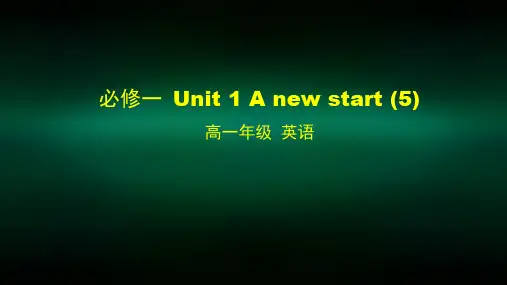
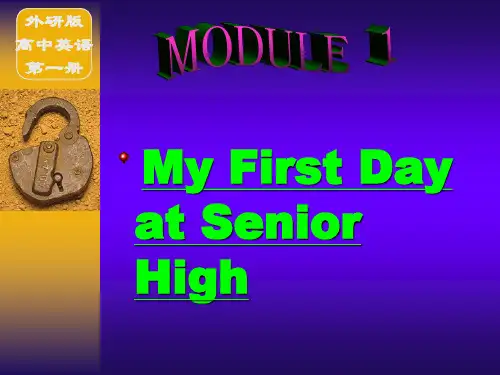
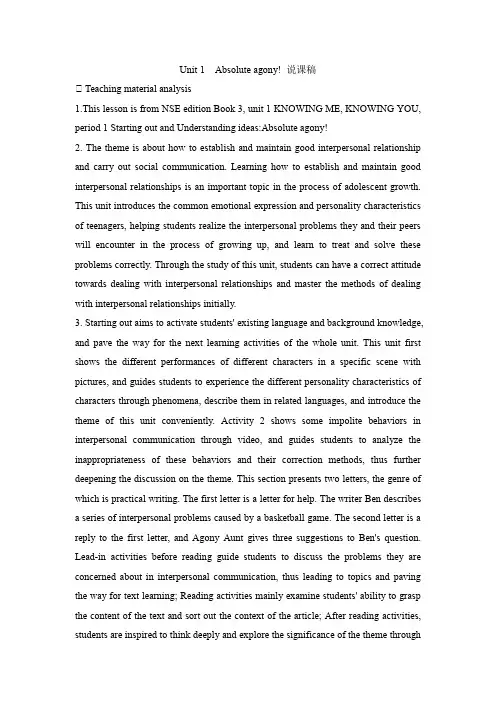
Unit 1 Absolute agony! 说课稿Ⅰ Teaching material analysis1.This lesson is from NSE edition Book 3, unit 1 KNOWING ME, KNOWING YOU, period 1 Starting out and Understanding ideas:Absolute agony!2. The theme is about how to establish and maintain good interpersonal relationship and carry out social communication. Learning how to establish and maintain good interpersonal relationships is an important topic in the process of adolescent growth. This unit introduces the common emotional expression and personality characteristics of teenagers, helping students realize the interpersonal problems they and their peers will encounter in the process of growing up, and learn to treat and solve these problems correctly. Through the study of this unit, students can have a correct attitude towards dealing with interpersonal relationships and master the methods of dealing with interpersonal relationships initially.3. Starting out aims to activate students' existing language and background knowledge, and pave the way for the next learning activities of the whole unit. This unit first shows the different performances of different characters in a specific scene with pictures, and guides students to experience the different personality characteristics of characters through phenomena, describe them in related languages, and introduce the theme of this unit conveniently. Activity 2 shows some impolite behaviors in interpersonal communication through video, and guides students to analyze the inappropriateness of these behaviors and their correction methods, thus further deepening the discussion on the theme. This section presents two letters, the genre of which is practical writing. The first letter is a letter for help. The writer Ben describes a series of interpersonal problems caused by a basketball game. The second letter is a reply to the first letter, and Agony Aunt gives three suggestions to Ben's question. Lead-in activities before reading guide students to discuss the problems they are concerned about in interpersonal communication, thus leading to topics and paving the way for text learning; Reading activities mainly examine students' ability to grasp the content of the text and sort out the context of the article; After reading activities, students are inspired to think deeply and explore the significance of the theme throughactivities such as summarizing the main idea, understanding the details and connecting themselves with open questions and answers.Ⅰ Students analysisFirst of all, senior one students have a sense of learning. A small number of students have formed good study habits in junior high school, and most students can familiarize themselves with the text in advance. Secondly, for learning strategies, students use them properly in their studies, but only at the most basic level. At the same time, through the study of this class, students can actively think about some open problems and have their own opinions, which shows that the thinking ability of senior high school students is more mature and dialectical thinking and creative thinking have developed greatly. In group cooperative learning, it can be seen that the consciousness of high school students' cognitive activities is obviously enhanced, and the self-evaluation and self-control ability of cognitive system is also greatly improved.Ⅰ Teaching objectivesBy the end of this period, Students will be able to:1. Look at the picture, and analyze the personality of the people in the picture;2. Think about who do they turn to for help when they face problems;3. Perceive the key structure, and understand the main idea of the two letters;4. Deepen understanding of the theme of the unit and encourage them to form healthy and correct relationship with others.Ⅰ Key and difficult points of teaching1. Lead students to read independently, understand the main ideas, and gain more details;2. Guide students to form healthy and correct relationship with others.Ⅰ Teaching methods, Learning methods Teaching aids1.Teaching methods: Task-based teaching method2.Learning methods: Individual work, pair work & group work;Learning English in real situations.3.Teaching aids: Blackboard, multimedia, Chalks.Ⅰ Teaching proceduresStep I Lead in(5 mins)Activity 1 Look at the pictureLook at the picture and describe what each person is doing, and talk about what kind of person they might be.Suggested answer:1 He is sitting alone. He looks disappointed. He may be a quiet person.2 He is eager to have/eat food. He may be hungry. It seems that he loves eating.3 He is quarrelling with another guy. He looks angry. He may be short-tempered.4 He is talking with some people excitedly. He looks delighted. He may be friendly/outgoing.5 She is offering cakes to a guy happily. She looks hospitable. She may be a kind girl.6 She has broken a cup. She looks frightened. She may be a careless girl. (Purpose:Arouse students' interest through observation and analysis, and students can achieve the goal of initially introducing topics by observing the characters' personalities in the pictures.)Step II Pre-reading(5 mins)Activity 1 Answer questionQuestion:Who will you turn to for help when you face a problem?• friends• parents• teachers• online forums• no one – you prefer to keep things to yourself• other____________________________________________________Suggested answer:Students’ own answer(Purpose:By guiding students to understand relevant background information and activating their thinking, we can achieve the goal of helping students understand the text by providing relevant background information.)Step III While-reading(17 mins)Activity 1 Read for main ideaRead the letters and find out what kind of problems Ben has and who he turns to for help.Suggested answer:Ben believed one of his teammates let down the whole team and told it to his best friend. But then his friend told everyone else what Ben had said. Now Ben is at a loss for what to do, and he turns to Agony Aunt for help.(Purpose:Guide students to further understand the content of the article and achieve the goal of testing students' acquisition of relevant information and basis from the text.)Activity 2 Complete the diagramComplete the sentences with expressions from the passage.Suggested answer:1 the team were let down2 to let off team3 went and told everyone else what I’d said4 apologize to your teammate5 communicating with each other clearly6 resolving conflicts7 repeating what you said8 making the situation worse9 say too much10 think first, speak later(Purpose:By reading the article, students can grasp the main idea of the article, atthe same time grasp the text structure and extract relevant information from the article, so as to achieve the goal of testing students' understanding of the article and grasping the content.)Step IV Post-reading(15 mins)Students go through the two questions and think about them individually, then they discuss the questions in groups, and the teacher invites some students to share the answers with the class.Questions:1 What do you think of Agony Aunt’s advice? What other advice would you give to Ben?2 What is your understanding of the saying “Loose lips sink ships”? Do you know any similar sayings in Chinese?Suggested answer:Students’ own answer(Purpose: Further help students to deeply understand the information conveyed by the text on the basis of understanding the text, improve dialectical thinking and achieve the goal of further deepening the understanding of the article.)Step V Homework & Student Self-Evaluation (3mins)Please write a letter to Agony Aunt’s and tell her the difficulties that you meet recently.(Purpose:Deepen students' understanding of unit topics and discourse topics, guide students to dig deeper into their understanding of themselves, and achieve the goal of guiding students to practice.)Student Self-EvaluationThink about who do they turn to for help when they face problemsPerceive the key structure, and understand the main idea of the two lettersDeepen understanding of the theme of the unit and encourage them to form healthy and correct relationship with othersⅠ Blackboard design。
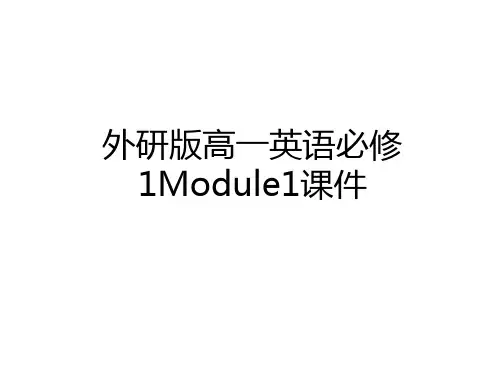
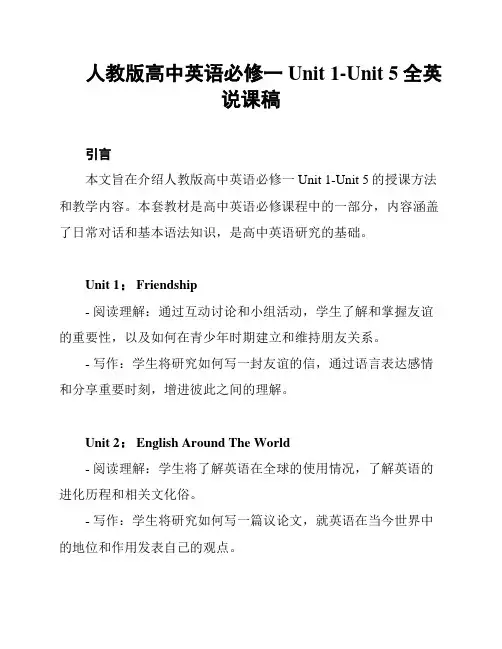
人教版高中英语必修一Unit 1-Unit 5全英说课稿引言本文旨在介绍人教版高中英语必修一Unit 1-Unit 5的授课方法和教学内容。
本套教材是高中英语必修课程中的一部分,内容涵盖了日常对话和基本语法知识,是高中英语研究的基础。
Unit 1: Friendship- 阅读理解:通过互动讨论和小组活动,学生了解和掌握友谊的重要性,以及如何在青少年时期建立和维持朋友关系。
- 写作:学生将研究如何写一封友谊的信,通过语言表达感情和分享重要时刻,增进彼此之间的理解。
Unit 2: English Around The World- 阅读理解:学生将了解英语在全球的使用情况,了解英语的进化历程和相关文化俗。
- 写作:学生将研究如何写一篇议论文,就英语在当今世界中的地位和作用发表自己的观点。
Unit 3: Travel journal- 阅读理解:通过阅读游记和旅行日记,学生将扩大英语词汇量和了解不同的文化和历史。
- 写作:学生将研究如何写一篇旅行日记,描述自己的旅行经历和感悟,提高英语写作的能力。
Unit 4: Amazing Science- 阅读理解:学生将了解科学发展的历史,以及人类对自然的探索和解释;学会如何从科学文章中获取信息。
- 写作:学生将研究如何写一篇科普短文,介绍感兴趣的科学领域的最新进展。
Unit 5: Music- 阅读理解:学生将了解音乐的历史和文化,掌握音乐相关的词汇和概念。
- 写作:学生将研究如何写一篇关于音乐的文章,和同学分享自己对音乐的喜好和见解。
结论本文介绍了人教版高中英语必修一Unit 1-Unit 5的授课方法和教学内容,通过丰富的教学活动和提高英语写作能力,全面提升学生的英语水平和综合素质。

新人教版必修一Unit1 Teenage lifeReading and thinking---The freshman challenges 说课稿Good even ing,honorable judges.It’s my great honor to share my lesson design with you. The content of my lesson is Senior English Book 1 Unit 1 Teenage life Reading and thinking part. My lesson design includes7 sections. They’re teaching background, teaching objectives, key and difficult points of teaching, teaching methods, teaching procedures, blackboard design as well as teaching reflection.1.Teaching background1)Theoretical basisFirst, let me talk about teaching background, which includes 3 parts--theoretical basis, analysis of material and analysis of students. The first theory I depend on is English Subject Core Competence,which emphasizes the importance of developing students’ language ability, learning ability,thinking capacity and cultural awareness. All of this can be shown in learning activities. The second is the View of English Learning Activities, which sets a solid foundationfor my teaching procedure.The activities I designed are graded from easy ones to difficult ones. The third theory I’m based on is Constructivism Learning Theory. It is students-centred, focusing on capacity building and emphasizes the situational scene of knowledge. Besides, it focus on cooperative learning and integrated learning activities. All of these ideas can be shown in the learning activities.2)Analysis of materialThenI analyze the teaching material from three dimensions what how and why.What covers the theme and the content. The theme of this section is humans and self. The type of this section is reading and thinking. It's a narrative in the first person whose topic is the freshman challenge. How involves the structure of the text. It’s general and specific.Why refers to the intention of this text, which aims to develop students positive attitude towards challenges and to compare school lives at home and abroad.3)Analysis of studentsThen I adopt SWOT model to analyze the target students. The students are freshman in senior one at Enping No.1 Middle School. They are active to create and eager to explore. Meanwhile, they have the similar experience while the weakness is that they have difficulty in understanding the cross culture knowledge, such as soup kitchen.Besides they will learn from Adam about how to overcome challenges in their school lives.Moreover, to improve their ability of reading and express their challenge and school lives in English is a potential challenge for them.2.Teaching ObjectivesBased on the analysis of teaching material and target students, the teaching objectives are designed as follows, which highlight the CoreCompetence and reflect the cognitive levels.By the end of the class students should be able to:(1)Know some words and phrases related to challenges through theme-based reading, such as freshman, suitable, confusing, freshman and so on.(2)Enhance thinking ability, such as creative and critical thinking throughprediction, further thinking and discussion.(3)Sort out and introduce the information about challenges through a mind map(4)Develop a positive attitude towards challenges in life3.Key and Difficult pointsThekey points are through theme-based reading, students can acquire information about challenges in three aspects —“What”, “How” and “Attitude”.Through a mind map, students can sort out and introduce the information about challenges. Through thought-inspired questions, students can develop a positive attitude towards challenges in life. To sort out and introduce the information about challenges through a mind map is difficult.4.Teaching MethodI will use situational language teaching, task-based language teaching method and communicative language teaching in this lesson.5.Teaching ProcedureIn my teaching design, there are 3 periods--learning, applying and transferring.I will explain them step by step.To start with, they can see a picture of the Wechat history with Adam and answer the questions based on it to lead in the topic, which also helps to relate to their personal experience. In the second step, students are required to predict the quality of Adam and what the passage is mainly about based on the pictures and title. In the third step, student should read for the main ideas with skimming skills,and step 4 is reading for the detailed information. They are asked to draw a mind map with the given clues, which can develop their integrated learning ability, language ability and thinking quality. The fifth is further thinking, they can infer what kind of person Adam is and find the supporting details by cooperating with their group members. Later share the answer on the blackboard, developing their cooperative learning ability, thinking quality and cultural awareness. After that, ask students to discuss about their own freshman challenges, which is a good way to relate to their reality and put what they have learned into practice. A presentation of their works is followed,in which students' communication ability and thinking ability are improved. Students' works are added on the blackboard to further improve the mind map and realize the learning process of "co-construction between teachers and students". Finally, I extend to the challenges in life, which aims to deepen their understanding of challenges and hold a positive attitude towards all the challenges they face in their lives.When the class comes to an end, the students are required to finish the checklist on the handout to see what they have learned through this lesson. Their homework is to write their challenge report. This is an output, consolidating knowledge and laying a foundation for the later learning of this unit.6.Blackboard DesignThis is my blackboard design, a mind map. Through the cooperation between teachers and students, a knowledge network based on the topic context of "challenges" is constructed. Generative learning outcomes give students a moreintuitive and in-depth language experience.7.Teaching ReflectionStudents have a clear knowledge network based on the topic context of "challenges" . In general, all the activities are well organized and the students are active in the whole class. However, they find it hard to draw a mind map. Because time is limited, there is a lack of further exploration of the theme. I will have them trained to draw mind maps and read more materials about challenge.That’s all for my teaching design. Thank you for your attention.。
高一必修一英语讲课稿:unit5 Nelson Mandela ----A modern hero姚雁我今日所说的课题是高中一年级英语上册第 5 单元 Nelson?Mandela—a?modern?hero。
我讲课的内容包含五部分,包含讲课标、教材剖析,学情剖析和教课方法的选择,教课过程。
一、 ?讲课标新课程标准的三维教课观,详细到英语学科就是要整合发展学生语言技术、语言知识、感情态度、学习策略和文化意识五个方面的修养,培育学生综合运用语言的能力。
指出:“教师在教课才过程中应与学生踊跃互动、共同发展。
教师应尊敬学生的人品,关注个体差别,知足不一样学生的学习需要,创建能指引学生主动参加的教育环境,激发学生的学习踊跃性,培育学生掌握和运用知识的态度和能力,使每个学生都能获得充足的发展。
所以,本课的设计要点是:帮助学生形成自主、合作、研究的学习模式,掌握阅读的一些基本技巧,让每个学生在原有的基础上都学有所得。
二、教材剖析1.教材内容剖析今日我讲课的内容是高一英语必修 1 第五单元 Nelson?Mandela—a?modern?hero,.本单元议论的话题是“ great?people”介绍了几位伟人的平生易伟人身上的质量,主要内容是环绕今世英豪纳尔逊?曼德拉睁开的。
经过学习本单元内容,学生学习伟大人物的优异质量,不停提升自己的品行涵养。
2、教课目的剖析新课标提出了立体三维教课目的,本课我设计的教课目的以下:1)知识目标:熟习本课的一些新单词 ,短语和句型。
语法方面掌握语法方面掌握以where,when, why,介词 +which,介词 +whom 指引的定语从句2)能力目标:训练学生的阅读技巧 (略读、寻读等 ),形成用英语获守信息、办理剖析信息的能力。
并鼓舞学生张口说英语。
3)感情态度目标:①经过学习激发学生对英语学习的浓重兴趣;②使学生在领悟语言丰富多彩性的同时学习伟大人物的优异质量,不停提升自己的品行涵养。
高一英语必修一unit1教案【5篇】高一英语必修一unit1教案(精选篇1)教学目标1.知识目标:1)Students should learn some useful words and phrases: musician,clap, passer-by, form, extra, earn, advertisement,2 attractive, instrument,loosely, actor dream of, be honest with, play jokes on, or so, break up.3)Students should understand the general idea of the passage2.语言能力目标:1)Developthe Ss’skills of skimming, scanning and careful reading.2) Train the Ss to findthe key words and the topic sentences.3)Encourage the Ssto guess the new wordsaccording the reading.3.情感态度与文化意识目标:1)Encourage the Ss to share the differentkinds of music.2)Improve the cooperation and share among the students.教学重难点1、教学重点:a.To understudend the passage better b.To find the main idea of eachparagraph2、教学难点:a.Master the reading ability b.Develop the skills ofreading教学过程教学设计本节课共45分钟,具体教学步骤如下:Step I Leading-in播放一段小视频,内容为歌曲 If you arehappy的英文版本,通过介绍演唱乐队twins引出本单元话题。